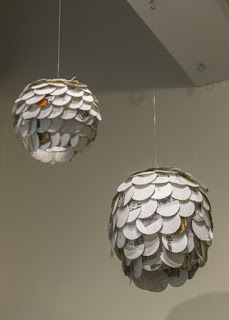The Library is proud to have worked with the School of Communication and Creative Industries in the production of the School’s current exhibition, Recycled Reading.
 |
| Recycled Reading exhibition at HR Gallop Gallery – Photograph: James Farley |
The exhibition was conceived by Dr Sue Wood, who was eager to repurpose some of the Library’s de-accessioned items. De-accessioning involves the removal of outdated material from the Library’s collection to make way for new resources that better support the University’s teaching and research priorities. The Library was pleased to donate de-accessioned items as a way of giving second-life to some old books.
 |
| Artist: Hayley Hillis – Photograph: James Farley |
Books are a fascinating source of inspiration both for the way their physical nature impacts upon us (that old book smell is so good they’re making scented candles) and what they mean to us as readers (like the bitter-sweet feeling of finishing a book). The history of the book goes back thousands of years from the first scrawled symbols to the sophisticated publishing processes available today. The physical vessel onto which thoughts and ideas have been writ developed from basic resources such as wood, bronze and plant matter, to more sophisticated materials like papyrus and then parchment. These days books are printed on diverse manufactured materials, including paper, plastic and electronic formats, which can be slipped and shared between readers more efficiently than any other form in history.
 |
| Artist: Kerri-Anne Chin – Photograph: James Farley |
But what of the book as an art form? Many people are familiar with illuminated manuscripts, such as the Book of Kells, and can appreciate rich visual nature of the book. However, the advent of the printed press, growing interest in science from an increasingly literate society, and recognition of artists as creatives rather than craftspeople caused the book to move away from visual to textual (Benton, 2008, p.495). While the printing press may have become the predominate publisher of the text-book, artists continued to publish visual-books. William Blake’s (1757-1827) Songs of innocence and experience (1789-1832) is an example of an artist’s illuminated manuscript.
 |
| Artist: Jamie Holcombe – Photograph: James Farley |
 |
| Artist: Padraig McNamara – Photograph: James Farley |
Post-printing-press, many artists have become interested in transforming
textual books into artwork by defacing and deconstructing, cutting and
pasting, appropriating and expanding, and sculpting and shaping. Today
there are many artists and non-artists alike who seek to repurpose books
both as art and for craft projects.
For this exhibition a selection of books were distributed at random to participating SCCI faculty members, whose only brief was to respond in some way to the original content of the book. This led to a wide variety of responses: some books retained their bookish-looks, changing within their skin; some were chopped and changed, transformed into functions and bold statements; and still others transcended their physicality entirely, reminiscent of electronic publishing. The artworks in this exhibition are candid, humorous and thought-provoking responses to the form and content unique to each book, and the Library values this collaboration with SCCI.
 |
| Artist: James Farley – Photograph: James Farley |
 |
| Artist: Tim Crutchett – Photograph: James Farley |
 |
| Artist: Sarah Beltrame – Photograph: James Farley |
 |
| Artist: Jacob Raupach – Photograph: James Farley |
 |
| Artist: Damian Candusso – Photograph: James Farley |
 |
| Artist: Chris Orchard – Photograph: James Farley |
 |
| Artist: Belinda Paulovich – Photograph: James Farley |
 |
| Artist: Dr Sam Bowker – Photograph: James Farley |
Recycled Reading is on display in the HR Gallop Gallery, Building 21, Wagga Wagga, until this Friday 28 August 2015.
References
Benton, M. L. The book as art. In S. Eliot & J. Rose (Eds.). A companion to the history of the book. Malden, MA: Blackwell.
Like this:
Like Loading...
Discover more from Charles Sturt University Library Blog
Subscribe to get the latest posts sent to your email.












